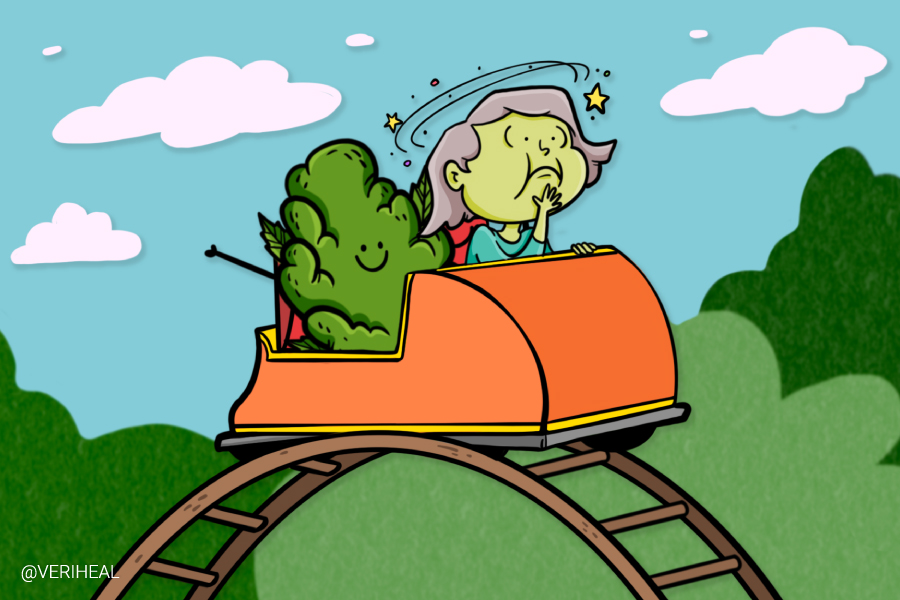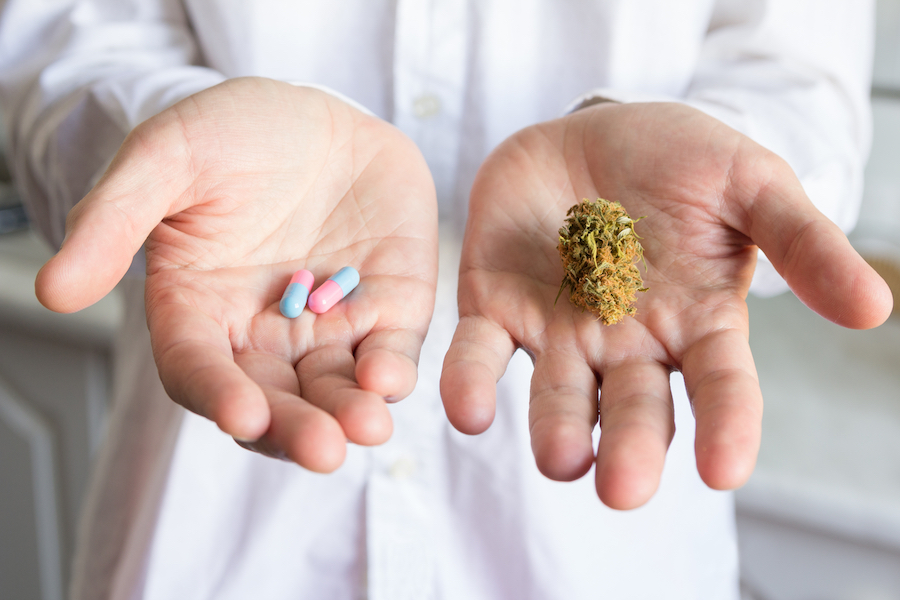Medical Marijuana for Nausea Relief: Can Patients Benefit?

Key Takeaways: Medical Cannabis for Nausea
Cannabis, specifically its compounds THC (tetrahydrocannabinol) and CBD (cannabidiol), has demonstrated its potential to alleviate nausea and vomiting, offering relief for individuals dealing with these symptoms. THC, known for its psychoactive effects, plays a key role in activating CB1 receptors in the brain, affecting neurotransmitters associated with nausea control. This makes cannabis, or medications containing THC, effective in mitigating nausea, particularly in contexts like chemotherapy-induced nausea and vomiting (CINV).
In addition to THC, CBD (cannabidiol), a non-psychoactive component of cannabis, has also shown anti-nausea properties. CBD interacts with serotonin receptors and other pathways, contributing to its potential effectiveness in relieving nausea. The combined action of THC and CBD, or the use of CBD alone, provides patients with options that may suit their preferences and medical needs.
While promising, it’s crucial to note that individual responses to cannabis can vary, and the legal landscape surrounding cannabis may impact accessibility. As with any medical intervention, consultation with healthcare professionals is essential to ensure safe and effective use, especially considering potential side effects and interactions with other medications. Further research is needed to refine dosages, formulations, and to establish the long-term safety of using cannabis for nausea relief.
The Science Behind Medical Cannabis for Nausea
- Treating Nausea with Medical Cannabis
- Treating Chemotherapy-related Nausea and Vomiting with Cannabis
- Treating HIV-Related Nausea with Cannabis
- Does Weed Help With Food Poisoning?
- Cannabis-Derived Prescription Medications for Nausea
Cannabis works within the human body to activate the endocannabinoid system. Endocannabinoids are fat-based neurotransmitters that activate both CB1 and CB2, the cannabinoid receptors throughout the body. Endocannabinoids are also naturally produced by the body. Check out our guide on endocannabinoids to learn more about how this works.
Endocannabinoids can be agonist, or excitatory, meaning they can increase the effect felt by neurotransmitters in the body. They can also be antagonist, or inhibitory, and decrease the levels of a particular neurotransmitter in the body. This is important to note, because the psychoactive component of cannabis, Δ9-tetrahydrocannabinol (THC), can be an agonist and antagonist of the CB1 and CB2 receptors, depending on the amount consumed. Cannabidiol (CBD) is an antagonist, meaning it works the opposite of THC (8).
Essentially, in larger doses, THC activates the CB1 receptors in the dorsal vagus complex, the nerve responsible for controlling emesis, or vomiting. In addition, CB1 receptors in the gastrointestinal tract actually slow down motility, or digestion (5) and contribute to the opposite of their anti-nausea effects in the brain.
Treating Nausea with Medical Cannabis
Relatively high THC cannabis is recommended for treating nausea over using CBD-only products, according to the Australian Department of Health (1). It is important to note that in rare cases, prolonged use of cannabis may cause cannabinoid hyperemesis syndrome, a syndrome that causes cyclical vomiting until use is stopped, and may need ER treatment for secondary dehydration or other complications (10).
If smoking to manage nausea, it is important to pick high THC cannabis plant flower, because this chemical compound directly affects the dorsal vagus nerve, which controls nausea and vomiting responses in humans (5). Another ideal option is using a vaporizer or vape pen if the patient is worried about smoke being harmful (3). Smoking or vaping may carry additional health risks.
Because orally taking cannabis takes an hour to two hours to start taking effect and lasts longer in the body, many patients prefer to inhale cannabis for immediate relief and quicker offset. When taking medical marijuana orally, it can be more difficult to adjust exact dosages, but it can deliver cannabinoids (chemical compounds found in marijuana) without the need for smoking or vaping (3).
Pros of medical marijuana for nausea
- Shown to control nausea in cancer patients, a population that doesn’t always get severe nausea control with traditional antiemetics, or anti-nausea medications (4)
- Slows intestinal motility (5)
- Increases appetite (2)
Cons of medical marijuana for nausea (1)
- Dysphoria or depression (9)
- Hallucinations
- Paranoid delusions
- Dizziness (9)
- Drowsiness
- Dry mouth
- Potential for cyclic vomiting syndrome in high doses
It is important to consult your doctor about marijuana for medical purposes such as ongoing nausea and vomiting because it may not be effective for your situation or it may interact with other medications you may be taking. Nausea and vomiting carry a broad differential diagnosis and may represent a more serious condition, so visiting your healthcare provider are necessary first. Seek emergency care for repeated or uncontrolled vomiting.
Treating Chemotherapy-Related Nausea and Vomiting with Cannabis
High THC doses of cannabis are recommended for the treatment of cancer-related nausea due to chemotherapy (1). Research shows that cannabinoids, including prescription-based ones, are more effective than traditional medications for nausea at reducing vomiting and nausea for patients undergoing cancer chemotherapy. If you are receiving emetogenic chemotherapy treatment, a type of chemotherapy that causes larger amounts of vomiting and nausea, cannabis is not more effective than anti-nausea medications for symptom relief (2).
A 2016 review discusses the research of cannabis and nausea, noting that activation of the endocannabinoid system can increase the endocannabinoids anandamide (AEA) and 2-arachidonoylglycerol (2-AG) when a patient is experiencing motion sickness or after receiving certain types of anesthesia. Unfortunately, this evidence has been shown in animal studies but has yet to be clinically researched in humans (11).
Additionally, there is promising evidence that cannabis may help the 25- 59% of chemotherapy patients who develop anticipatory nausea. Anticipatory nausea happens when a patient’s acute nausea from chemotherapy is not properly treated and then the patient has a conditioned response of being nauseated when returning to the clinic for more treatment sessions. Researchers believe that, unlike traditional antiemetics, cannabis has the ability to help this group of patients (11).
It is important to take into consideration that some highly concentrated THC and CBD oil extracts are being promoted as potential cancer cures, but these products have not been evaluated in clinical trials (2). It is best to stay away from products that say they can cure cancer.
Please see our cancer page for more information on medicinal marijuana and cancer.
Treating HIV-Related Nausea with Cannabis
Many patients with human immunodeficiency virus (HIV) take medications to suppress the effects of the virus on their body, but then suffer side effects of these medications. These antiviral medications, called protease inhibitors, are highly effective at helping patients from getting sick, but cause nausea and vomiting that is similar to chemotherapy-induced nausea (3).
In HIV patients, studies support medical marijuana use and dronabinol to treat nausea and cachexia or wasting syndrome, which causes severe weight loss. When patients were given larger doses of cannabis or dronabinol, their weight increased between 3.5-3.9% percent; this is something that traditional medications for nausea have not been shown to improve (9).
More research needs to be done in this area as many of these studies are short and contain a small number of participants or some research bias when it comes to dronabinol (12).
Check out our informative page on HIV.
Does Weed Help With Food Poisoning?
A growing body of evidence supports the idea that cannabis could be beneficial for specific symptoms of food poisoning, including nausea and vomiting. Nevertheless, more research is necessary to determine the true potential of cannabis in helping with food poisoning.
Alongside studies that indicate that weed may help with nausea related to chemotherapy and HIV/AIDS, there is evidence suggesting that cannabis may aid in managing other gastrointestinal conditions, such as irritable bowel syndrome (IBS), inflammatory bowel disease (IBD), ulcers, gastritis, and even appetite stimulation for individuals struggling with disordered eating.
THC is believed to activate CB1 receptors in higher doses, particularly influencing the dorsal vagus complex, a nerve crucial in controlling vomiting. However, when stimulated by cannabinoids like CBD and THC, the vagus nerve may lose some ability to affect heart rates, leading to concerns about an increased risk of heart attacks. More research is necessary to fully understand the implications of this effect.
The effectiveness of cannabis in alleviating symptoms may depend on consumption methods and product types. A 2022 study involving over 800 individuals across more than 2200 self-administered sessions found that flower and concentrates were more effective in treating nausea compared to tinctures and edibles. Joints were reported to offer greater symptom relief than pipes and vaporizers, and THC appeared to be more beneficial than CBD.
Nevertheless, this research is amongst very few studies that discuss cannabis and nausea. Further research is required to definitively conclude the effectiveness of cannabis for symptoms of food poisoning.
Cannabis-Derived Prescription Medications for Nausea
The following are marijuana-derived or synthetic cannabinoid medications that treat nausea. The first two are approved by the U.S. Food and Drug Administration (FDA).
Dronabinol (Brand name Marinol) (1)
- For effective treatment of chemotherapy-induced nausea and vomiting, cancer-associated nausea and vomiting, and HIV associated nausea and vomiting
- Contains synthetic THC (2)
- Taken orally by capsule
- Analysis of studies show low to moderate quality of information
- Shown to be as effective as traditional antiemetics, or anti-nausea medications in treating chemotherapy-induced nausea (11)
Nabilone (Brand name Cesamet) (1)
- For cancer-associated nausea and vomiting, HIV/AIDs related nausea and vomiting, and chemotherapy-induced nausea and vomiting
- Synthetic THC (2)
- Taken orally by capsule
- Studies have been determined to be very low to moderate in quality
- Shown to be more effective than traditional antiemetics, or anti-nausea medications (11)
Nabiximols (1)
- Treats chemotherapy-induced nausea and vomiting as well as increases appetite in cancer patients
- A mixture of ethanol extracts of THC and CBD in a 1:1 ratio (2)
- A liquid spray that absorbs oromuscosally, or through the cheeks in the mouth
- Insufficient evidence for controlling nausea and vomiting, but shown to be as effective in the reviewed and completed study (11)
Levontradol (1)
- For treatment of chemotherapy-induced nausea and vomiting
- Injection into muscles
- Low to moderate quality of evidence from studies analyzed
- Insufficient evidence for controlling nausea and vomiting
It is recommended that you speak with your physician about nausea treatment before using medical marijuana. Everyone responds differently to medications in general. A medical marijuana doctor on Veriheal’s platform may be able to help you figure out dosages to control your nausea as well as address any concerns you may have regarding the psychoactive properties of marijuana.
Note: Veriheal does not intend to give this as professional medical advice. Do not attempt to self-diagnose, or prescribe treatment based on the information provided on this page. Always consult a physician before making any decision on the treatment of a medical condition.
1. Australian Government Department of Health. Therapeutic Goods Administration. (2017, December 21). Guidance for the use of medicinal cannabis for the prevention or management of nausea and vomiting in Australia. Retrieved January 23, 2021, from https://www.tga.gov.au/publication/guidance-use-medicinal-cannabis-prevention-or-management-nausea-and-vomiting-australia
2. Cannabis and Cannabinoids (PDQ®)–Health Professional Version. (2020, November 6). Retrieved January 23, 2021, from https://www.cancer.gov/about-cancer/treatment/cam/hp/cannabis-pdq#link/_40_toc
3. Mack A, Joy J. Marijuana as Medicine? The Science Beyond the Controversy. Washington (DC): National Academies Press (US); 2000. 5, MARIJUANA AND AIDS. Available from: https://www.ncbi.nlm.nih.gov/books/NBK224400/
4. Martínez, V., Iriondo De-Hond, A., Borrelli, F., Capasso, R., Del Castillo, M. D., & Abalo, R. (2020). Cannabidiol and Other Non-Psychoactive Cannabinoids for Prevention and Treatment of Gastrointestinal Disorders: Useful Nutraceuticals?. International journal of molecular sciences, 21(9), 3067. https://www.ncbi.nlm.nih.gov/pmc/articles/PMC7246936/
5. Parker, L. A., Rock, E. M., & Limebeer, C. L. (2011). Regulation of nausea and vomiting by cannabinoids. British journal of pharmacology, 163(7), 1411–1422. https://www.ncbi.nlm.nih.gov/pmc/articles/PMC3165951/
6. Rock, E. M., Bolognini, D., Limebeer, C. L., Cascio, M. G., Anavi-Goffer, S., Fletcher, P. J., Mechoulam, R., Pertwee, R. G., & Parker, L. A. (2012). Cannabidiol, a non-psychotropic component of cannabis, attenuates vomiting and nausea-like behaviour via indirect agonism of 5-HT(1A) somatodendritic autoreceptors in the dorsal raphe nucleus. British journal of pharmacology, 165(8), 2620–2634. https://bpspubs.onlinelibrary.wiley.com/doi/full/10.1111/j.1476-5381.2011.01621.x
7. Rock, E. M., & Parker, L. A. (2013). Effect of low doses of cannabidiolic acid and ondansetron on LiCl-induced conditioned gaping (a model of nausea-induced behavior) in rats. British journal of pharmacology, 169(3), 685–692. https://bpspubs.onlinelibrary.wiley.com/doi/10.1111/bph.12162
8. Pertwee R. G. (2008). The diverse CB1 and CB2 receptor pharmacology of three plant cannabinoids: delta9-tetrahydrocannabinol, cannabidiol and delta9-tetrahydrocannabivarin. British journal of pharmacology, 153(2), 199–215. https://pubmed.ncbi.nlm.nih.gov/17828291/
9. National Academies of Sciences, Engineering, and Medicine 2017. The Health Effects of Cannabis and Cannabinoids: The Current State of Evidence and Recommendations for Research. Washington, DC: The National Academies Press. https://www.nap.edu/catalog/24625/the-health-effects-of-cannabis-and-cannabinoids-the-current-state
10. Pergolizzi Jr., J., LeQuang, J., & Bisney, J. (2018). Cannabinoid hyperemesis. Medical Cannabis and Cannabinoids, 1(2), 73-95. https://www.karger.com/article/fulltext/494992
11. Rock, E. M., Sticht, M. A., Limebeer, C. L., & Parker, L. A. (2016). Cannabinoid regulation of acute and anticipatory nausea. Cannabis and Cannabinoid Research, 1(1), 113-121. https://www.liebertpub.com/doi/10.1089/can.2016.0006
12. Whiting, P. F., Wolff, R. F., Deshpande, S., Di Nisio, M., Duffy, S., Hernandez, A. V., . . . Kleijnen, J. (2015). Cannabinoids for medical use. JAMA, 313(24), 2456. https://jamanetwork.com/journals/jama/fullarticle/2338251








